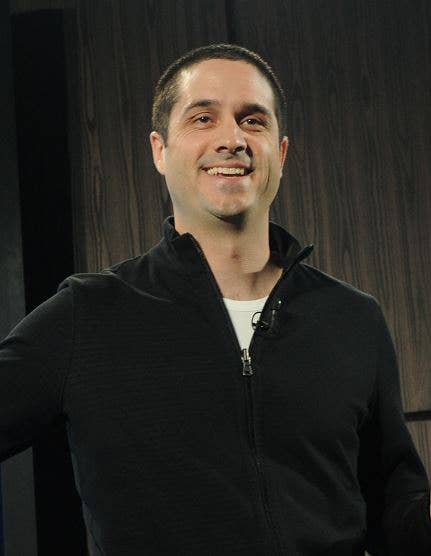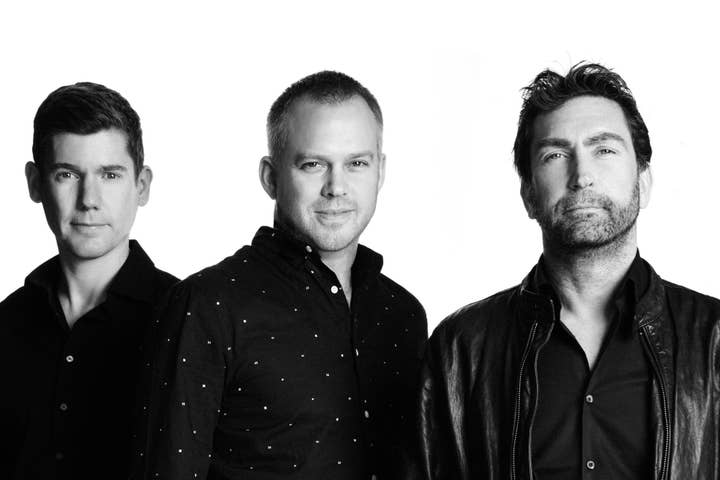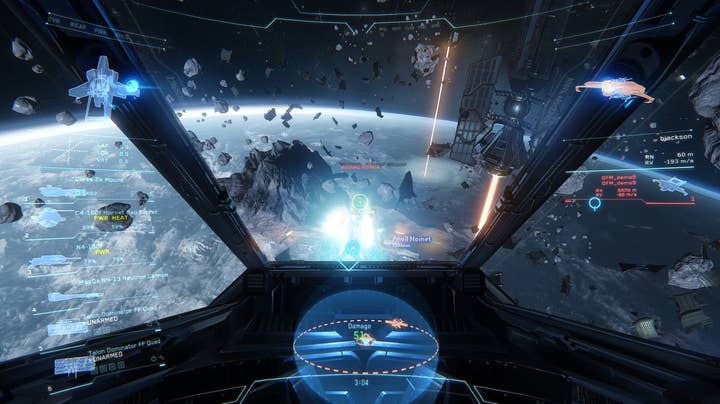Amazon Lumberyard: One Year On
Mike Frazzini on the engine's first twelve months, how it attracts high-profile studios, and distancing the tech from CryEngine
In 2016, Amazon announced itself as the surprise new entrant in the game engine space.
Already a competitive sector led by Unreal and Unity, the advent of Amazon's Lumberyard toolset stemmed from a licensing deal with Crytek, essentially reshaping the firm's powerful CryEngine in its own image. Despite the distinct advantages and legacies of its rivals, Lumberyard has been able to entice high-profile studios old and new, even converting some previous CryEngine customers.
With the engine's first anniversary now passed, we caught up with Mike Frazzini, VP of Amazon Games, during GDC to look back at this formative period. Frazzini is quick to highlight the amount of work Amazon's team has poured into Lumberyard, with nine major updates and over 2,000 improvements, fixes or additions made. But the most rewarding development for the exec has been the response from studios.

"We knew when we started that building a great game engine was going to take time and we wanted to make sure that we were very focused on customers," Frazzini tells GamesIndustry.biz. "We've exceeded all of our expectations in terms of customer adoption - that was really cool. When we launched, the reception from customers, both the volume and the positivity were really high, and then the actual usage on a week-to-week and month-to-month basis has exceeded expectations.
"If you ever design or build a product, it's really nice to have customers because they tell you exactly what they need. It'll be like: "We could be doing these nine things but everyone's asking for these two so why don't we do those first?" That level of precision has really been fantastic for our engineering teams."
While Frazzini gushes with pride over the adoption rate, he says he is unable to actually disclose how many studios have embraced the new tech. But he assures us that plenty of developers are now building games with Lumberyard - they're just not ready to announce them yet.
"Games development typically takes more than a year, so we have way more projects that are in development"
"We're a year in," he observes, "and games development typically takes more than a year, so we have way more projects that are in development. As these games are released to the public, we'll of course be open about it. This is just a natural aspect of games development. It takes time."
The customers Frazzini can talk about are certainly noteworthy. Star Citizen creator Cloud Imperium Games dropped CryEngine in favour of Lumberyard, and ex-Grand Theft Auto developer Leslie Benzies is using the engine to power his mysterious new project, Everywhere. Even smaller developers - such as Slingshot Cartel, the new studio from the founders of FreeStyle Games - are exploring the possibilities Lumberyard offers in sectors such as eSports. Each of these signings helps to raise the engine's profile in their own way.
"It helps a lot," Frazzini says. "Developers might like where we're going but they want to know if it's being used by anyone. It's really important for us to be able to talk about these projects when they're amongst the most ambitious games being made in the industry."

Ambitious is certainly a word Frazzini would use to describe about Benzies' debut title. While he can't go into detail, it's hard not to be intrigued by his genuine excitement about the new game concept behind Everywhere.
"A lot of people are excited about what [Benzies and his team] plan to deliver, and we want to do everything we can to help them"
"That was such a fun conversation," he recalls. "They came out and told us the game they had in mind, and I was like "wow, that sounds awesome". The team he's pulling together - and, of course, Leslie himself - are really talented, and they were able to have long conversations directly with the engineers that were building the systems they were thinking of using. I think a lot of people are excited about what they plan to deliver, and we certainly want to do everything we can to help them."
As Frazzini regularly says throughout any interview, Amazon's determination to be customer-focused means he and his team are keen to meet developers' needs. A conversation between the games VP and Cloud Imperium founder Chris Roberts proved that, despite being so new to the market, Lumberyard is already on the right track.
"[Roberts] said, "hey, I really thought it'd be cool to integrate with Twitch, and I have this idea where it'd be nice for a broadcaster to pull people in from chat to play". And we were like, "We agree. We did that with a feature called JoinIn, which does that at the click of a button". And he was like, "That's cool. I also really think it'd be great if..." and we were like, "Yeah, we do too. We built that." He just kept finding that his vision for the things he wanted from the technology and different services, we were really aligned and in some cases - I think it was over half - we had actually built a lot of the tech he was describing, and we were able to show it to him."

Integration with Twitch is very much Lumberyard's key selling point. Since the streaming service is also owned by Amazon, the engine has the advantage of a much closer relationship that empowers developers to build games with livestreams in mind. As well as the JoinIn feature, there is also functionality such as ChatPlay, which lets devs create titles where Twitch viewers can spawn items and enemies or trigger in-game events purely by typing the required code word into the chat. This level of interaction is something Frazzini believes will not only be crucial to the future of Lumberyard, but video games in general.
"In our view, all games are going to want those things," he says. "I think about 85% of the top PC and console games by revenue are multiplayer. Look at the mobile top sellers list, how many have cloud connectivity? They all do. Communities and cloud are two critical areas of development.
"At Amazon, we have the sandbox of Twitch, Twitch Prime, Amazon Web Services and the Amazon retail business. When we bring all those tools into Lumberyard, it just makes it that much easier to draw from them."
Frazzini goes onto to say that, given Amazon's ownership of Twitch, it's important for Lumberyard to cater as much for streamers as it does developers: "We keep saying that games studios are our customers, but broadcasters are too. They're extremely important customers.
"The cool thing about game developers and broadcasters is that the thing they want are often in alignment"
"The cool thing about game developers and broadcasters is that the things they want are often in alignment. A broadcaster wants people to be able to join their game from chat, and developers are like, "Why wouldn't we want to make that easier? It totally makes sense". We're seeing a lot of alignment between the features we can build for broadcasters and the utilities they can give to developers at the same time."
Other companies are also vying to get streamers on side. Last year, Microsoft acquired similar service Beam in an attempt to rival Twitch, and at GDC 2017 it announced a series of new features coming to Xbox One that would enable more interactivity between broadcasters and their audience. With Beam, viewers are able to use sound boards and screen effects to interact with their stream, enhance the streamer's weapons with power-ups, or even take on the hosts head-to-head if chosen to join the game. Is this not a threat to Twitch, and by extension Lumberyard?
"First of all, we're customer-focused, not competitor-focused," says Frazzini. "We pay attention to competitors, and certainly keep up with the news of what's going on in the industry, but we focus on customers.
"The notion of online communities of fans is a frontier. We are just getting started. Games have always been about community - you think about the arcade, or your buddy's basement, or the virtual couch with Xbox Live and things like that. What we see today is the number of ways to create and share content, or participate in communities, is expanding. The number of customers is expanding. The amount of time they're spending on games is expanding. You look across things between modding, fansites, Reddit, Twitch, YouTube - those are all examples of games as community experiences. So when we see other companies pop up and do other things in this space, it's just more evidence that this is an interesting frontier and there's a lot of cool opportunities to deliver [these experiences] to customers."

The attitude of "customer-focused, not competitor-focused" is one familiar to anyone that has spoken to Frazzini before, and perhaps it's a sensible stance to take. When combined, Unreal, Unity and CryEngine have decades of experience when it comes to catering to developers, while Amazon's wider games business (let alone engine development) only dates back a few years. It's a reality the company is all too aware of, increasingly ensuring that its various developer services actually integrate with other toolsets - potentially at the expense of Lumberyard.
"When we built GameLift," Frazzini offers by way of example, "we wanted to make it easier for developers to scale their multiplayer servers. Scaling your servers is hard, even with all those tools and a good infrastructure. Say you have 1,000 customers, then 1m, then 5m, then back down to 1m - you see lots of games struggle with this. That was an opportunity we saw.
"When we built the service and launched it, developers were like, "Well, we need Linux support." And we were like, "Oh, that makes sense. Crap, we've got to get Linux support." And then they said, "Hey, we really like this service, we want to use it in our own in-house engine, or Unreal or Unity." So we're like, "Okay, we gotta build that." When it launched, GameLift was Windows-based, Lumberyard-only. Today, it's any C++ or C# engine, it includes Linux support, we added a matchmaking feature and toolset into it because that's one of the most common things we heard from customers."
The relationship between Lumberyard and one particular competitor is the most intriguing: CryEngine. Amazon's toolset is built on Crytek's code, so when the Germany-based firm found itself in financial trouble once again last year, speculation was rife as to how this might affect Lumberyard.
"CryEngine was a starting point. At this point, over 50% of the code in Lumberyard is written by Amazon engineers"
"CryEngine was a starting point," Frazzini explains. "At this point, over 50% of the code in Lumberyard is written by Amazon engineers. We don't have an active commercial or strategic relationship with Crytek. We wish them the best, but where they go from here is entirely separate and different from anything we're doing with Lumberyard."
While those ties may be severed, there were still high expectations for Amazon to come in and rescue Crytek from its woes again. Having already arranged the licensing deal that enabled the creation of Lumberyard, many believed the firm might acquire Crytek entirely and perhaps merge the two engines together. We asked Frazzini if that was ever a consideration as Crytek found itself in dire straits.
"That's a very reasonable question," he says politely, "but you're getting into the rumours and speculation."
So what does year two hold for Lumberyard? With so many unannounced projects from unknown developers, we can expect to get a better idea of who has adopted the technology. In terms of what studios can hope for from the engine itself, Frazzini promises just as much dedication as his team has shown over the first year.
"When we launched, there was a lot of interest in the product but there was also a lot of shortcomings," he says. "We had to work our butts off to fill some of those gaps. At this point, the reception we've had in the last couple of weeks has been really positive, so I think we're on the right track."
He continued: "I don't want to over-commit to forward-looking roadmap stuff. At Amazon, we like to talk about things when customers can use them. We're really focused around productivity, performance, flexibility, integrations with the cloud, integrations with Twitch, and ultimately at the end of the year I'd say we kinda want customers to say, "These guys are great listeners. We love what they've done, we love where they're going and we like working with them." We just want to continue to get better and better."
